Felt’s 2011 DA

It's instructive to consider where Felt's DA was, versus where it now is. You know, of course, where I'm always going to look first, don't you? At how it fits, and how I feel once I board the bike.
What I mean by that is, literally, how am I going to feel. What am I going to feel? What am I touching? What's touching me? Where am I displacing my weight?
My body's posture once seated on the bike determines my leverage and power, aerodynamics, visibility, safety, and a large part of my comfort. Those points where I contact the bike determine the rest of my comfort, and that will also impact my power and aerodynamics (how many top Tour riders did you see squirming during the TT, moving back and forth on the saddle, not really able to strike and hold a proper posture?).
Let me start by saying that the 2004 Felt DA (its last year in production prior to 2011) was an unrideable bike. I believe I did say this in 2004. I wasn't picking on Felt alone. In the earlier part of the decade Trek, Specialized, and other significant companies made equally unrideable bikes. So, no great sin there. Still, that vintage DA, and, its 74° seat angle combined with its low front end, made certain that Cirque du Soleil's contortionist was the only potential customer for whom that bike would be appropriate.
Let's contrast that with what I saw last week at Felt's 2011 media soirée. Just about every meaningful North American cycling magazine or portal attended, maybe two dozen in all. One of these magazines asked the question about the DA's seatpost: "What about those who want to sit in a more traditional position? That seat post doesn't seem to allow for that."
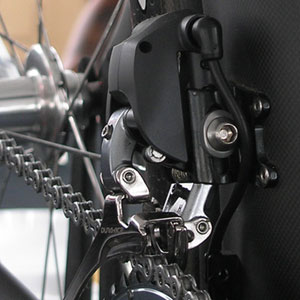
Felt's answer was delivered by skinny tire product manager Dave Koesel (Superdave on the Slowtwitch forum). He went on to explain that traditional saddle position—the road racer's TT position—as expressed through Felt's Garmin Transition riders, is no longer "traditional" or, to put it another way, there's a new tradition forming.
"We put all our riders in the wind tunnel," explained Koesel, "and to a person each rider chose the forward position on our two-position seat post. So, we now make a one position post [deleting that rearward option].
"We have a rear position post available," continued Koesel, but it was clear that this new 78°, forward position post was not only a bike for triathletes, it's the most appropriate geometry for the Garmin Transitions riders as well.
This confirms Cervelo's original demonstration that its tri geometry bikes were not only workable for pro road racers, the geometry was ideal for them. The DA also mirrors Trek's Speed Concept models: We're not building TT bikes and selling them to triathletes, contends Trek. We're building tri bikes and that's what our pro teams are riding during their TTs.
These three companies—Trek, Felt and Cervelo—now unequivocally state: There is zero space between TT geometry and tri geometry, even for UCI rule encumbered riders. I think Specialized and Cannondale are close to stating that. To the degree that a company is not prepared to state that, and if its bikes reflect this ambivalence, it's bikes are less likely to be prime-time ready, for either tri or TT.
Let's leave geometry for awhile. I know you want to talk about the shape, and the gruppo.
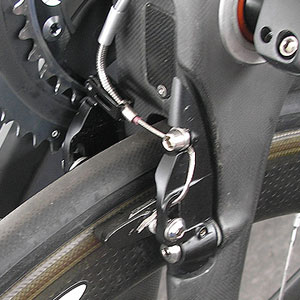
The DA's pipes are bigger than the Felt molds introduced in 07. The major diameters are all deeper, and the fork is a Bayonet 3, specific to this frame, and only usable on this frame. This is Felt's superbike, made to keep up with Joneses, and maybe exceed the Joneses.
The brake calipers—front and rear—are made by Felt for this frame mold only. There might be some Tektro sub-assemblies, but the calipers are Felt's, and one thing I like about these calipers is both front and rear have a 2.5mm Allen screw on each side to independently adjust distance from the rim. When you depress the brake levers, each caliper arm compresses the same distance, not like the Tektros many other bike companies are using that are a bear to adjust, and one side compresses more than the other.
The DA's new rear caliper sits underneath the chain stay, and that stay's mold is depressed to make room for the brake. Very sexy.
I rather prefer this brake set-up: rear caliper hidden down there, front caliper in front of the crown. This, because hiding the front caliper behind the crown is high-risk, low-reward. I've found that the front brake doesn't stop as well on these behind-the-crown mounts. But the rear, yes, get it out of the way of the air. The rear doesn't contribute that much to stopping power, but cleaning up that seat cluster is an aerodynamic imperative these days.
It's seems everybody's got to have their own aero narrative, and, Felt has one too. Its leading shapes—things that fair other things—feature an air trip: a flare-out just prior to the tube's rearward terminus. This keeps the air from closing in on the shape just behind the tube. The idea is to allow a rider to use a variety of wheels (for example) without having to worry so much about the aerodynamics of that particular wheel.
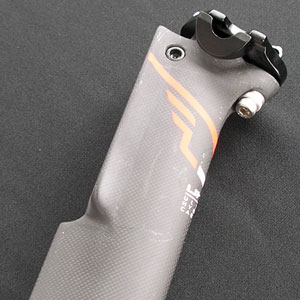
So, for example, you have Shimano's Di2 battery. Not very aero. But the DA seat post has that little air trip just at the seat post's trailing edge, and this—according to Felt—renders the battery's unaero shape moot.
This is a Di2 bike. Yes, you can cable the bike if, for example, you want to ride it with SRAM Red, or with cabled Dura Ace, but, you either buy the bare frame, or you buy it with Di2.
InsideOut Internal Molding Process
This new DA features a form of construction not often talked about in the world of bike building, but it's probably going to get more air play in the future. Felt calls it its InsideOut Internal Molding Process, and the real fight is going to be less among bike brands, more among bike factories that either are, or aren't, able to execute this process for the bike brands for whom they build.
You're probably familiar with the typical clamshell mold process, where the carbon lay-up is sandwiched in between an aluminum or stainless steel mold describing the bike's outside shape, and an inflatable air bladder inside the mold, inside the lay-up, pressing against the inside of the carbon, compressing the carbon against the inside of the clamshell mold.
The inflatable bladder is not able to get into the nooks and crannies of a frame's joints. The InsideOut process features a set of foam molds that detail the inside of each major frame joint (the bottom bracket area, for example). The bladder presses against these molds, and creates very tight, very lightweight, joint areas. You can't see this, because all this "finish work" exists on the inside of each frame.
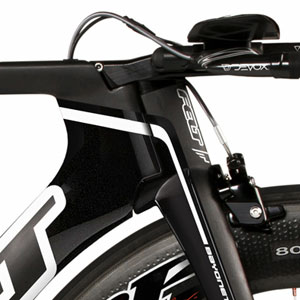
This adds cost. Each of these joint molds must be engineered, and the mold to make the mold must be constructed. This, times however many joints per frame size. This, times however many sizes in the model's size run (unless you can perchance double or triple up on some of the molds, depending on how each frame size is graded). And, each inside mold is good for only one bike frame.
That's the state of the art in bike making these days, and Felts will feature this process on their top-o'-the-line tri and road race bikes.
Parts
I'm building up a Di2 bike at the moment, and while I've ridden the road version of Di2, I've not ridden the tri version. But here's the thing: Di2 has much more utility for tri than for road. First, road bikes don't have the aero mandate that tri bikes have. Sure, it's nice if your road bike is aero, but, nobody loses much sleep if it's not.
Not so your tri bike. And, tri bikes have cables all over the place, sticking out everywhere. Especially shift cables. And then you have the great metaphysical question: Do I route my shift cables through my aerobar extensions? Or keep the extensions virginal, so that I can place my SaltStick dispensers there?
But the biggie: The TT group has shifters on BOTH the extensions AND the pursuit position. I'll have to see how much I actually use those pursuit shifters. But as my dear old dad used to say: Better to have them and not need them than need them and not have them.
So, lucky us: The most expensive gruppo in the world, while of limited utility to the people Shimano really wants to sell it to (road racers), actually has a compelling narrative for you and me (triathletes). If our lenders unfreeze our home equity lines of credit, maybe we'll be able to invest in one of these gruppos.
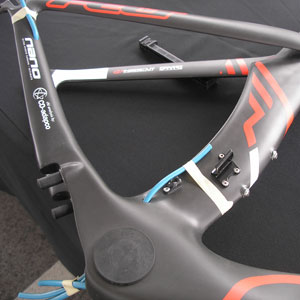
The aero bar is a Felt Devox, and, I quite like these bars. I've written about them elsewhere. The one thing you should know is that these are low profile bars, on a moderately low profile frame. If you look at the bike as Felt photographed it for publication, you can see how low it is. This particular set up (the pic at the very top of this article) is what Zabriskie and Vandevelde both ride (they each ride almost identical TT set ups). You probably won't ride this low. But the photo is a little bit misleading, because this bike pictured is built with a custom non-hinged, one-piece stem to make this bike even lower and lighter yet for Zabriskie/Vandevelde. You'll be riding a DA that has the more typical hinged stem characteristic of the Bayonet.
But it's still low, even with the slightly higher-profile hinged stem, so, I'll tell you right now the big mistake a lot of people are going to make: They're going to buy their Felts at least one size smaller than they ought. If this bike appeals to you—and this advice leverages across to all Felts built with Devox bars and Bayonet forks—figure out how to get the largest Felt size underneath you without having to ride a ridiculously short stem.
The saddle is Prologo, this is what Spartacus rides, but, I have no experience with this saddle. I'm no help to you.
The wheelset is a Zipp 808 front, and a 1080 rear. What? You already have race wheels? No problem, your retailer will absorb these back into his inventory for aftermarket sale.
Geometry
Felt's Bayonet 2 and Bayonet 3 are both lower profile than the Bayonet 1. Therefore, this makes bikes equipped with these forks, and Devox bars, subject to my exhortation above. Don't size down, size up. Get the largest size frame you can comfortably fit aboard.
The geometry chart is as of yet unpublished, but I'm assured it's geometrically similar to existing Felt models. In Felt's other models, the smallest two sizes are built in 650c—the 48cm and the 50cm—and Felt tells me they sell these two sizes in about equal numbers across their various tri models. This doesn't surprise me: The 50cm is a sleeper, and fills a void in the industry, that being a very fast, sprightly bike for those slightly taller than 5'5" and who can't otherwise find a 650c tri frame. But this is unlikely to be the case with the new DA, and this bike will probably feature fewer sizes than Felt's other models.
Felt's B-series mold features a 52cm and 54cm size that are very close one to the other. The 52cm is likely to be pushed down to 51cm and will be reworked, and this will probably cannibalize that 50cm 650c size. The probable line up in terms of size for 2011 will be 48, 51, 54, 56, 58cm. These will be the likely sizes for the 2011 DA. The other Felt models will remain geometrically as they are: same sizes, same molds.
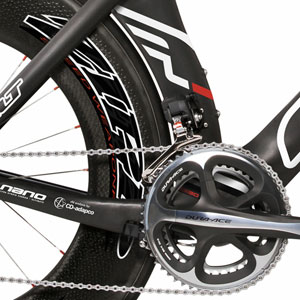
Interference drag
One other note about the aerodynamics. Felt makes a point of its engineering efforts to reduce interference drag. The fork's blades are conspicuously far apart from each other, starting at the Bayonet 3's crown, and the hub flanges are closer together than typical: spaced closer to 55mm in the front rather than your typical 80mm. Sometimes people ask why it is that so many bike splits from our QR bikes made 17 and 18 years ago stand up today. If you make your bikes with 78° seat angles, and proper geometry throughout; and you space your fork blades wide; and you built all your front hubs—training and racing wheels—with flanges 55cm and 60mm apart; likewise tightening the flange width in the rear hubs; you'll probably make fast bikes.
This same interference drag narrative is echoed by Trek. In fact, we wrote about this about a year ago. The moral of the story: good ideas may come and go, but if they go, don't despair, if you're patient they'll eventually return.
Price
There is no published price, but, if you buy it complete and as spec'd, this will be a 5-figure bike. Probably in the neighborhood of $12,500. But I wouldn't necessarily buy this bike spec'd off the shelf. I must assume that the candidate for this bike probably already has a set of race wheels. It is also my understanding that there is no performance drop-off when subbing an Ultegra cassette into a Di2 shift system. I don't think Dura Ace or, for that matter SRAM Red, or Campy Record, cassettes are always the best alternative. Often, titanium cogs offer worse shifting performance, and I think if you asked Andy Schleck he'd tell you that shifting performance is more important than a few grams of weight.
So, if you take off the needlessly expensive stuff—which your retailer would happily to absorb into his inventory—this bike probably comes in at $9000 and change. Yes, this is a lot of money, but, Felt needs this bike in its line-up to show that it can keep pace with all the other superbikes coming out, and, with the 2011 DA, Felt acquitted itself exceptionally well in its superbike effort. Start saving now, the DA should be on showroom floors just after the first of the year.


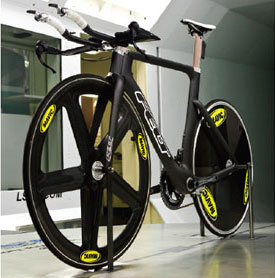
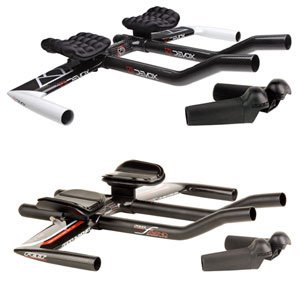
Start the discussion at slowtwitch.northend.network